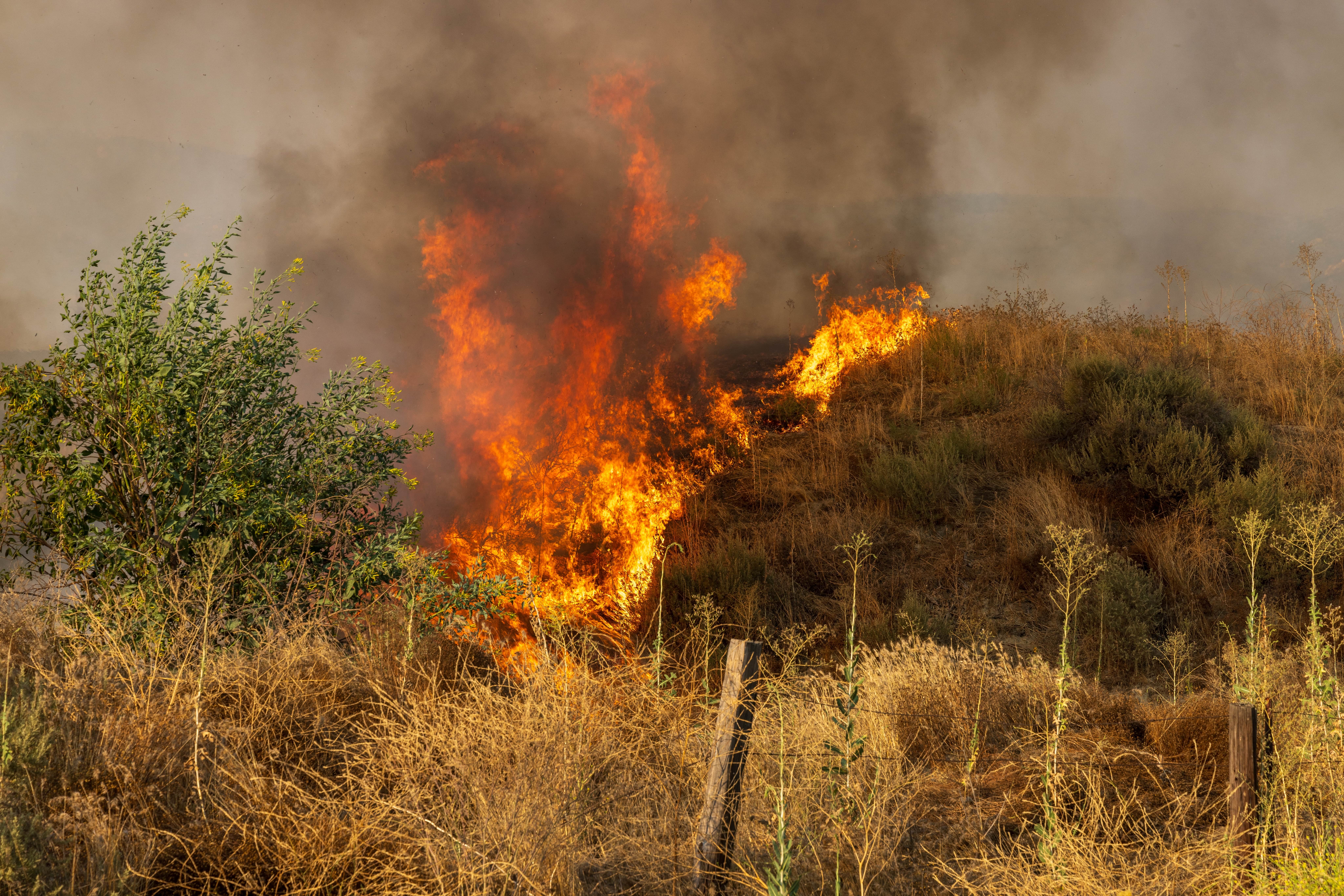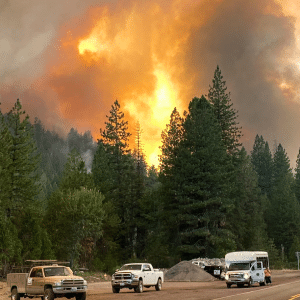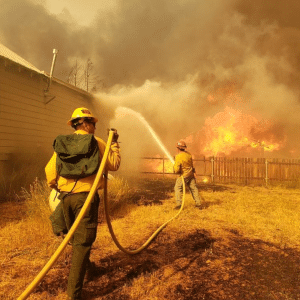
Wildfires are a growing threat to communities and businesses in California, and their impact may increase as climate change continues to exacerbate their frequency and severity.
In the United States, the cost of wildfire damage is billions. Estimates place the federal government spending at about $2.5 billion in fire suppression and $5 billion in disaster assistance from 2016 to 2020.
In 2020, the figures lay between $5 billion and $9 billion, and states like California are particularly at risk. A new analysis commissioned by several insurance associations in California has demonstrated that using a wildfire catastrophe model would increase the availability of insurance for homeowners facing the risk of climate-induced wildfires.
Currently, California is the only state that requires insurers to base their premiums for homeowners’ insurance on the historical experience of catastrophes. However, the insurance associations argue that this method is no longer effective in accurately assessing the growing threat of wildfires in the state.
Enter wildfire modeling. This advanced risk assessment tool helps insurance companies understand wildfires’ likelihood and potential impact on specific properties and communities. By analyzing factors such as weather patterns, vegetation, and topography, wildfire models can predict the spread and intensity of a fire and help insurance companies determine the appropriate coverage and pricing for their policies.
But wildfire modeling is not without its limitations. While it can provide valuable insights into the future wildfire risk of an area, it is an inexact science. Many variables can impact the accuracy of a wildfire model, including the quality of data input and the complexity of the model itself.
Despite these limitations, using wildfire modeling in the insurance industry has significant benefits. A report from Milliman compares the current approach with cat modeling, showing the impact on premiums and availability for homeowners in California. The analysis results indicate that using cat modeling would increase the availability of insurance for homeowners in the state, making it a valuable tool for insurance companies to manage the risk of wildfire damage.
This article will explore the use of wildfire modeling in the insurance industry and how it helps insurance companies assess and manage the risk of wildfire damage. We will discuss the benefits and limitations of using wildfire modeling and its impact on the availability and affordability of wildfire insurance for policyholders.
How Insurance Companies Use Wildfire Modeling
Insurance companies use wildfire modeling to understand and manage the risk of damage to their policyholders and communities. Here are some of the ways this tool can benefit insurance firms:
Assessing the Risks of Wildfires to Specific Properties and Communities
Insurance companies use wildfire modeling to assess the risk of damage to specific properties and communities. Wildfire models analyze a range of factors that can impact the spread and intensity of a wildfire, including weather patterns, vegetation, topography, and the likelihood of ignition. By analyzing these factors, wildfire models can predict a wildfire’s probability and potential impact on a specific property or community.
This information is critical for insurance companies, as it allows them better to understand the risk profile of a specific area and determine the appropriate coverage and pricing for their policies. For example, an insurance company may use a wildfire model to assess the risk of wildfire damage to a home in a high-risk area and offer a policy with higher coverage and premiums to reflect that risk. On the other hand, an insurer may offer a home in a low-risk area a policy with lower coverage and premiums.
Developing and Pricing Wildfire Insurance Policies
In addition to assessing the risk of wildfire damage, insurance companies also use wildfire modeling to develop and price their wildfire insurance policies. Wildfire models can help insurance companies understand the potential impact of a wildfire on their policyholders and communities, allowing them to create coverage options that meet the specific needs of their policyholders.
For example, an insurance company may use a wildfire model to determine the potential cost of rebuilding a home after a wildfire, which can inform the coverage limits and premiums of their wildfire insurance policies. By understanding the possible cost of rebuilding a home, insurance companies can offer policies with appropriate coverage limits and premiums to protect their policyholders from the financial impact of wildfire damage.
In addition to informing coverage limits and premiums, wildfire modeling can also help insurance companies understand the potential impact of a wildfire on their overall financial stability. By analyzing the possible cost of wildfire damage to their policyholders and communities, insurance companies can assess their ability to pay claims and make informed decisions about risk management strategies.
Using Wildfire Modeling for Wildfire Risk Management
Wildfire modeling can also play a role in wildfire risk management. Insurance companies may use wildfire models to analyze the potential impact of a wildfire on their policyholders and communities and develop strategies to mitigate or reduce the risk of wildfire damage. This may include implementing risk prevention measures, such as providing policyholders with resources to reduce the risk of wildfire damage to their homes or diversifying their risk portfolio by investing in risk management tools or strategies.
For example, an insurance company may use a wildfire model to identify high-risk areas and offer policyholders resources to reduce the risk of wildfire damage to their homes. This may include providing policyholders with information on creating defensible space around their homes, installing fire-resistant roofing materials, or installing sprinkler systems.
Insurance companies can help reduce the risk of wildfire damage and protect their policyholders and communities by providing these resources.
In addition to implementing risk prevention measures, insurance companies may also use wildfire modeling to diversify their risk portfolio. This may include investing in risk management tools or strategies, such as purchasing reinsurance or participating in risk pools. By diversifying their risk portfolio, insurance companies can better manage the financial impact of wildfire damage on their policyholders and communities.
Using Wildfire Modeling for Claims Management
Wildfire modeling can also play a role in claims management. After a wildfire, insurance companies must assess the cost of claims and manage the claims process efficiently to help policyholders recover from the financial impact of wildfire damage. Wildfire models can help insurance companies more accurately estimate the cost of claims by analyzing the potential impact of a wildfire on their policyholders and communities.
For example, an insurance company may use a wildfire model to predict the potential cost of rebuilding a home after a wildfire. By understanding the possible cost of rebuilding a home, insurance companies can more accurately estimate the cost of claims and manage their claims process more efficiently. This can help policyholders recover from the financial impact of wildfire damage more quickly and effectively.
In addition to helping insurance companies estimate the cost of claims, wildfire modeling can also inform their claims management strategies. By analyzing the potential impact of a wildfire on their policyholders and communities, insurance companies can develop strategies to streamline their claims process and better assist policy owners in recovering from wildfire damage.
Benefits and Limitations of Using Wildfire Modeling
 There are several advantages of using wildfire modeling in the insurance industry:
There are several advantages of using wildfire modeling in the insurance industry:
- Improved risk assessment: Wildfire modeling allows insurance companies to more accurately assess the risk of wildfire damage to specific properties and communities. By analyzing a range of factors that can impact the spread and intensity of a wildfire, insurance companies can better understand the risk profile of a specific area and determine the appropriate coverage and pricing for their policies.
- Tailored coverage options: Wildfire modeling can help insurance companies offer more tailored coverage options to their policyholders. By understanding the potential impact of a wildfire on a specific property or community, insurance companies can create coverage options that meet the particular needs of their policyholders.
- Enhanced risk management: Wildfire modeling can also play a role in risk management for insurance companies. By analyzing the potential impact of a wildfire on their policyholders and communities, insurance companies can develop strategies to mitigate or reduce the risk of wildfire damage. This may include implementing risk prevention measures or diversifying their risk portfolio.
- Improved claims management: Wildfire modeling can also enhance the claims management process for insurance companies. By accurately estimating the cost of claims, insurance companies can streamline their claims process and better assist policyholders in recovering from wildfire damage.
Limitations and Challenges of Using Wildfire Modeling
While wildfire modeling can provide valuable insights into the risk of wildfire damage, it is not an exact science and is subject to certain limitations and challenges:
- Quality of data input: A wildfire model’s accuracy depends on the data input’s quality. If the data used to build a model is incomplete or inaccurate, the model’s predictions may be flawed.
- The complexity of the model: The complexity of a wildfire model can also impact its accuracy. If a model is too complex, it may be challenging to interpret and be subject to overfitting, where the model too closely fits the data used to build it and may not accurately predict future events. It is vital for insurance companies to carefully consider the complexity of a wildfire model when using it in their risk assessment and policy pricing processes to ensure that it is accurate and useful.
- Uncertainty: Wildfire models are subject to uncertainty, as many variables can impact the spread and intensity of a wildfire. This can make it difficult to predict the likelihood and potential impact of a wildfire accurately.
- Limited scope: Wildfire models are typically focused on a specific area or region and may not be able to accurately predict the impact of a wildfire on a larger scale.
- Cost: Building and maintaining wildfire models can be costly. Insurance companies must carefully weigh the costs and benefits of using wildfire modeling in their risk assessment and policy pricing processes.
Wildfire modeling has many benefits and can provide valuable insights into the risk of wildfire damage. However, it is subject to certain limitations and challenges that insurance companies must consider when using in their risk assessment and policy pricing processes.
Examples of Insurance Companies Using Wildfire Modeling
Several examples of insurance companies have implemented wildfire modeling in their risk assessment and policy pricing processes. Here are a few case studies:
- Swiss Re: Swiss Re, a global reinsurance company, has implemented wildfire modeling as part of its risk assessment and policy pricing processes. By analyzing the potential impact of wildfires on their policyholders and communities, Swiss Re can offer more tailored coverage options and better manage their risk exposure.
- Allstate: Allstate, a large insurance company in the United States, has also implemented wildfire modeling as part of its risk assessment and policy pricing processes. By analyzing the potential impact of wildfires on their policyholders and communities, Allstate can offer more tailored coverage options and better manage their risk exposure.
- CSAA Insurance Group: The CSAA Insurance Group, which comprises several insurance companies, has a partnership with ZestyAI to implement a wildfire risk assessment model. By analyzing the potential impact of wildfires on their policyholders and communities, the CSAA Insurance Group can offer more tailored coverage options and better manage their risk exposure.
These case studies demonstrate how insurance companies can use wildfire modeling to assess and manage the risk of damage to their policyholders and communities. By analyzing the potential impact of wildfires on their policyholders and communities, insurance companies can offer more tailored coverage options and better manage their risk exposure.
It is important to note that these are just a few examples of insurance companies using wildfire modeling in their risk assessment and policy pricing processes. Many other insurance companies are likely using wildfire modeling in similar ways to assess and manage the risk of wildfire damage to their policyholders and communities.
Impact of Wildfire Modeling on the Availability and Affordability of Wildfire Insurance
Wildfire modeling can significantly influence the availability and affordability of wildfire insurance for homeowners and businesses. By using these models to assess the risk of wildfire damage, insurance companies can offer more tailored coverage options and better manage their risk exposure.
This can increase the availability of wildfire insurance in high-risk areas and potentially lower premiums for policyholders.
However, the impact of wildfire modeling on the affordability of wildfire insurance may be more complex. While wildfire modeling can help insurance companies more accurately assess the risk of wildfire damage, the perceived risk of wildfire damage in a specific area may still impact the cost of premiums.
For example, suppose the risk of wildfire damage is perceived to be high in a specific area. In that case, insurance companies may need to charge higher premiums to cover their increased risk exposure. This could make wildfire insurance less affordable for homeowners and businesses in these areas.
In addition, the willingness of insurance companies to offer coverage in high-risk areas can also impact the affordability of wildfire insurance. Suppose insurance companies are hesitant to provide coverage in high-risk areas due to the perceived risk of wildfire damage. In that case, the availability of wildfire insurance in these areas may be limited. This could make wildfire insurance less affordable or even unavailable for homeowners and businesses in these areas.
Potential Future Developments in Wildfire Modeling
 Several potential future developments in wildfire modeling could further improve the accuracy and usefulness of these models for the insurance industry. These developments may include:
Several potential future developments in wildfire modeling could further improve the accuracy and usefulness of these models for the insurance industry. These developments may include:
- Improved data input: As more data becomes available on the factors that impact the spread and intensity of wildfires, wildfire models can incorporate this data to improve their accuracy. This could include data on weather patterns, vegetation, topography, and other factors that can impact the spread and intensity of a wildfire.
- Enhanced predictive capabilities: Wildfire models may also become more advanced in predicting a wildfire’s future likelihood and potential impact. By analyzing historical data and incorporating data on likely future weather patterns and other factors, wildfire models can more accurately predict the future probability and potential impact of a wildfire.
- Greater integration with other risk assessment tools: Wildfire models may also become more integrated with other risk assessment tools, such as flood or earthquake models. By analyzing the potential impact of multiple types of natural disasters on a specific property or community, insurance companies can more accurately assess the overall risk profile of an area and offer more tailored coverage options.
- Greater use of artificial intelligence: Wildfire models may also use artificial intelligence (AI) to improve their accuracy and speed. Utilizing AI algorithms to analyze data and make predictions, wildfire models can more quickly and accurately assess the risk of damage to specific properties and communities.
The future is bright for wildfire models. With greater use of data and technology, these models will be able to provide more accurate risk assessments. As a result, insurance companies can offer better coverage options tailored to each property or community’s needs.
Get the Help You Need After a Wildfire With Nadrich Accident Injury Lawyers
Wildfire modeling has become an increasingly important tool for insurance companies as they assess and manage the risk of wildfire damage to their policyholders and communities. By using wildfire models to analyze the potential impact of wildfires on specific properties and communities, insurance companies can offer more tailored coverage options and better manage their risk exposure. This can increase the availability of wildfire insurance in high-risk areas and potentially lower premiums for policyholders.
However, the impact of wildfire modeling on the affordability of wildfire insurance may depend on the perceived risk of wildfire damage in a specific area and the willingness of insurance companies to offer coverage in those areas. Various limitations and challenges to using wildfire modeling include uncertainty, limited scope, and cost.
Despite these challenges, wildfire modeling has the potential to significantly improve the accuracy and usefulness of risk assessment and policy pricing processes for insurance companies. As the threat of climate-induced wildfires continues to grow, wildfire modeling will likely play an increasingly important role in the insurance industry.
If you have been affected by a wildfire and have questions about your insurance coverage, consult with an experienced California wildfire attorney. At Nadrich Accident Injury Lawyers, we have a long history of helping clients navigate the claims process and secure the compensation they deserve. Contact us today to learn more.

